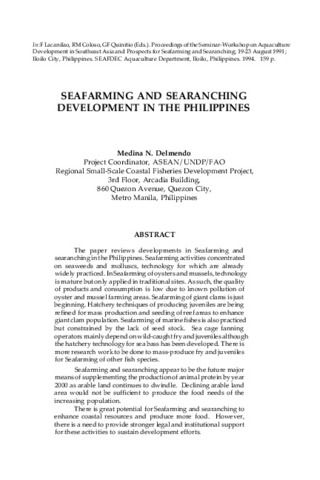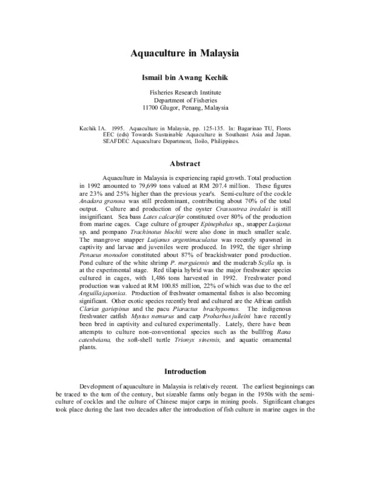Seafarming and searanching development in the Philippines
- Global styles
- MLA
- Vancouver
- Elsevier - Harvard
- APA
- Help
Share
Abstract
The paper reviews developments in Seafarming and searanching in the Philippines. Seafarming activities concentrated on seaweeds and molluscs, technology for which are already widely practiced. In Seafarming of oysters and mussels, technology is mature but only applied in traditional sites. As such, the quality of products and consumption is low due to known pollution of oyster and mussel farming areas. Seafarming of giant clams is just beginning. Hatchery techniques of producing juveniles are being refined for mass production and seeding of reef areas to enhance giant clam population. Seafarming of marine fishes is also practiced but constrained by the lack of seed stock. Sea cage fanning operators mainly depend on wild-caught fry and juveniles although the hatchery technology for sea bass has been developed. There is more research work to be done to mass-produce fry and juveniles for Seafarming of other fish species.
Seafarming and searanching appear to be the future major means of supplementing the production of animal protein by year 2000 as arable land continues to dwindle. Declining arable land area would not be sufficient to produce the food needs of the increasing population.
There is great potential for Seafarming and searanching to enhance coastal resources and produce more food. However, there is a need to provide stronger legal and institutional support for these activities to sustain development efforts.
Suggested Citation
Delmendo, M. N. (1994). Seafarming and searanching development in the Philippines. In F. Lacanilao, R. M. Coloso, & G. F. Quinitio (Eds.), Proceedings of the Seminar-Workshop on Aquaculture Development in Southeast Asia and Prospects for Seafarming and Searanching; 19-23 August 1991; Iloilo City, Philippines. (pp. 105-114). Tigbauan, Iloilo, Philippines: Aquaculture Department, Southeast Asian Fisheries Development Center.
Type
Conference paperISBN
971851127XKoleksi
- ADSEA '91 [21]
Related items
Showing items related by title, author, creator and subject.
-
Aquaculture industry profile and trends
Yap, Wilfredo G. (University of the Philippines Aquaculture Society, Inc., 2001) -
Aquaculture in Malaysia
Kechik, Ismail bin Awang. (Aquaculture Department, Southeast Asian Fisheries Development Center, 1995)Aquaculture in Malaysia is experiencing rapid growth. Total production in 1992 amounted to 79,699 tons valued at RM 207.4 million. These figures are 23% and 25% higher than the previous year's. Semi-culture of the cockle ... -
Coastal aquaculture in Thailand
Sahavacharin, Songchai (Aquaculture Department, Southeast Asian Fisheries Development Center, 1995)Coastal aquaculture in Thailand has expanded rapidly in both area and production in the last decade. The important cultured species are the shrimps (Penaeus monodon and P. merguiensis), sea bass Lates calcarifer, groupers ...






